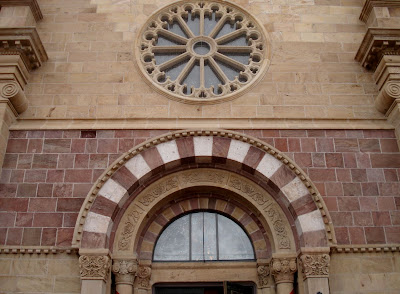
(The best single source is Floyd S. Fierman’s article The Triangle and the Tetragrammaton, which appeared in several forms. The one I consulted was from the New Mexico Historical Quarterly, v. 37, n.4, pg. 310-323, 1962.)

Many of the stories revolve around Bishop Lamy’s relationship with the Jewish community in Santa Fe, in particular with Abraham Staab. Born in Germany in 1839, Staab had emigrated in 1854, eventually arriving in Santa Fe around 1857, where he established a trading and merchandising operation throughout the southwest. By the 1870s he was a prominent businessman and in the position to lend Lamy money for the Cathedral.
Fierman wrote that the most detailed account of Staab’s connection to the symbol is from William Keleher’s The Fabulous Frontier. Keleher described how Staab had lent Lamy money for the Cathedral construction and how Staab said he would absolve all debts if he could chisel one word into the building’s entrance. Of course that word was Yahweh.
Keleher wrote that the source for his version was Staab’s son-in-law, who claimed that Staab had told this story on many occasions. In contrast, Fierman notes that Staab’s son Edward “avers under no circumstances” was there a trade of money for said carving. His father did destroy the notes, however, but “he did not bargain with the highest religious officer of the diocese.”
Continuing to seek out a reason for the symbol, Fierman wrote to Fray Angelico Chavez of the Cathedral, who had done extensive research into the history of the building. Chavez responded that the placement of the Tetragrammaton in a triangle was a common Christian symbol in Europe. It represented the holy trinity and was most likely something Lamy had seen in his youth in France. Chavez concluded “It also could be, once the emblem was carved, that these Jewish friends, totally ignorant of the triangle’s meaning, were actually pleased and did consider it a friendly gesture by Lamy! Which is all to good in this world of strife and misunderstanding among peoples.”